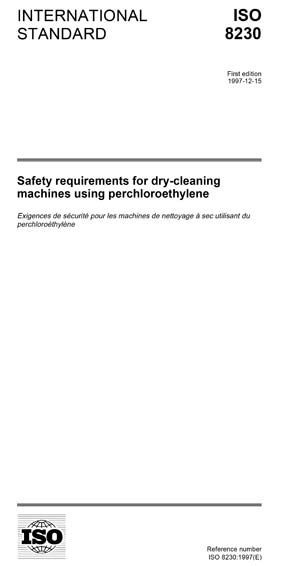Historical
ISO 8230:1997
Safety requirements for dry-cleaning machines using perchloroethylene
This International Standard is applicable to closed-circuit dry-cleaning machines of all sizes intended for industrial use (including retail shop operation) for the cleaning of articles made of textile, leather, furs and skins, using perchloroethylene1) (commonly shortened to perc) only as liquid solvent.
This International Standard is not applicable to:
- machines placed at the disposal of the general public (e.g. self-service);
- open-circuit dry-cleaning machines using perc and working below atmospheric pressure;
- barrier machines;
- ironing presses (see ISO 10472-1 and ISO 10472-6);
- machines with automatic doors;
- ancillary equipment, e.g. room evacuation equipment, waste recuperation systems of the still, external water cooling systems or complementary systems for perc recovery from the oil in the still.
This International Standard identifies all significant hazards arising from the use of the machine with special emphasis on solvent hazards, where “use of the machine” comprises both intended use and foreseeable abnormal situations. No specific technical advice is given for hazards (apart from the use of the machines) arising during construction, transport and commissioning, decommissioning, dismantling and disposal of the machines.
This International Standard applies primarily to machines manufactured after the date of issue of this standard.
It does not give specific technical advice about:
- pneumatic systems;
- noise;
- hazards caused by processing work which may create an explosive atmosphere (e.g. printers' wipers containing a low-flash solvent);
- machines processing loads which may contain “foreign solvents” which could lead to a change in a property (characteristic) of the cleaning solvent perc, e.g. cause foaming or make it carcinogenic;
- hazards caused by neglect of ergonomic principles;
- measures dealing with the containment of pressure in the machine.
The guidance contained in this International Standard is based on the presumption that the designer has completed a risk analysis of the machine under consideration, see EN 1050. This will enable him to identify and fulfill the significant requirements for his machine as stipulated by this International Standard.
Where for clarity an example of a safety measure is given in the text, this should not be considered as the only possible solution. Any other solution leading to the same risk reduction is permissible if an equivalent level of safety is achieved, evidence of which should be given in the manufacturer's documentation.
1) IUPAC name tetrachloroethene, chemical formula Cl2C = CCl2
International Organization for Standardization [iso]

